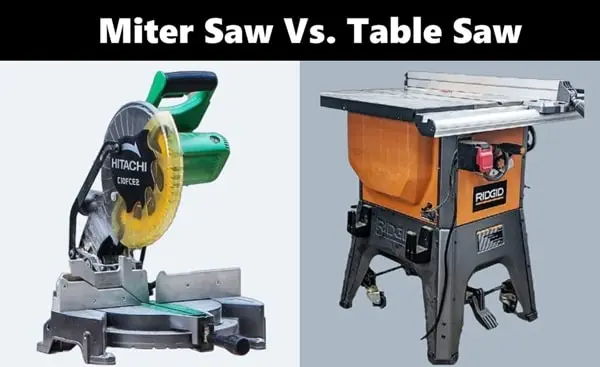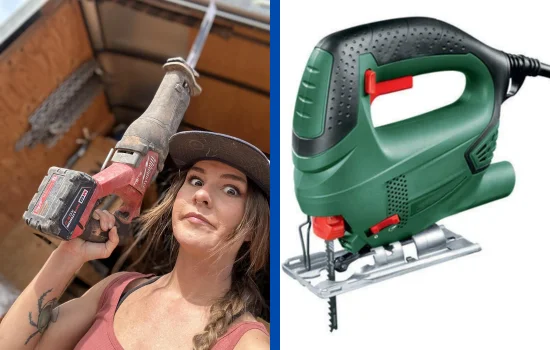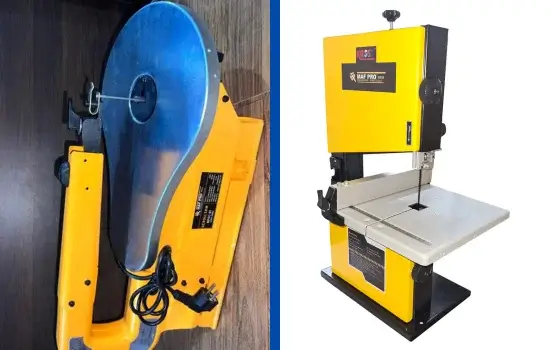Choosing between a miter saw and a table saw is a critical decision for any woodworker or DIY enthusiast. Both tools serve distinct purposes and are optimized for specific types of cuts and projects. While the miter saw shines in making precise angle cuts, the table saw is unmatched in making long, straight cuts across various materials. Understanding the unique strengths, weaknesses, and ideal applications for each can help you determine the right tool for your workshop.
Overview of Miter Saw and Table Saw
Miter Saw
A miter saw is a specialized tool primarily used for making precise angle cuts. Its rotating blade pivots on an arm to cut across the workpiece at specific angles, which is perfect for cutting trim, molding, or frames. Many miter saws offer bevel and compound cut options, making them versatile for certain angled cuts that go beyond simple crosscuts.
Table Saw
A table saw, on the other hand, is a workbench-mounted tool with a flat surface and a blade that protrudes through the center. It is highly effective for making long, straight cuts (rip cuts) along the length of a board. Table saws are particularly useful for cutting larger panels and sheets, offering the stability needed for heavy-duty work.
Key Differences Between Miter Saw and Table Saw
Let’s compare these tools across various categories to provide a clearer picture of their individual capabilities.
| Feature | Miter Saw | Table Saw |
|---|---|---|
| Primary Function | Angle and crosscuts | Rip cuts and long, straight cuts |
| Blade Motion | Downward pivoting action | Fixed, with the material fed into the blade |
| Cutting Capability | Crosscuts, miters, bevels, and compound cuts | Rip cuts, crosscuts, bevels |
| Precision | High precision for angle cuts | High precision for straight cuts |
| Portability | Generally lightweight and portable | Heavier, typically stationary |
| Blade Size | Smaller (7-12 inches) | Larger (10-12 inches or more) |
| Cutting Depth | Limited to 6-8 inches depending on the saw | Can handle larger and thicker materials |
| Applications | Trim, molding, framing, smaller wood pieces | Sheet goods, cabinetry, large panels |
| Safety Features | Blade guard, lock-off switch | Blade guard, riving knife, anti-kickback pawls |
| Cost | Mid-range to high | Mid-range to high |
Detailed Comparison of Miter Saw and Table Saw
1. Primary Purpose and Cutting Capabilities
- Miter Saw: A miter saw is optimized for making crosscuts and angle cuts. It excels in tasks where precision is key, especially when cutting small pieces of wood at specific angles. Common applications include trim work, baseboards, crown molding, and framing.
- Table Saw: Table saws are designed for rip cuts, making them the preferred choice for cutting large pieces of wood along the grain. They are invaluable for cabinet making, furniture design, and any project requiring precise long cuts. They can also make crosscuts with an added miter gauge but are less specialized for this than miter saws.
2. Precision and Adjustability
- Miter Saw: With its adjustable arm, a miter saw is well-suited for making exact angle cuts. Many models offer detents or preset stops at common angles (such as 45° and 90°), allowing users to make accurate and repeatable cuts. The addition of bevel capabilities in some miter saws adds versatility for compound cuts.
- Table Saw: The table saw is primarily designed for straight cuts but can also make bevel cuts if the blade is tiltable. It is highly precise for rip cuts and is usually equipped with a fence system to maintain cutting accuracy. However, making angled cuts is more challenging and typically requires a sled or additional jigs.
3. Ease of Use and Portability
- Miter Saw: Miter saws are generally lightweight and easy to move around, making them convenient for on-site jobs. Compact and portable miter saws are also available for even easier transport. Due to their smaller size and design, they don’t take up much space in a workshop.
- Table Saw: Table saws are usually heavier, and many models are built as stationary units due to their large size and the stable work surface they require. While there are portable table saws, even these are relatively heavy and take up more space than miter saws.
4. Blade Size and Cutting Depth
- Miter Saw: Miter saws generally come with blades ranging from 7 to 12 inches, with the most common sizes being 10 and 12 inches. They are suitable for smaller pieces of wood, but their cutting depth is limited. A 12-inch miter saw blade can handle wood pieces up to around 6 inches wide with the help of a sliding feature.
- Table Saw: Table saw blades are typically 10 or 12 inches and can handle thicker, larger materials, making them ideal for working with sheet goods or larger boards. They also allow for more continuous cutting without needing to adjust the material’s position constantly.
5. Safety Features
- Miter Saw: Miter saws are often equipped with blade guards, lock-off switches, and in some models, laser guides to enhance precision. The blade itself is relatively safe because it’s only exposed during the cutting process and retracts once the cut is complete.
- Table Saw: Table saws typically come with several safety features to prevent accidents. Most models include a riving knife or splitter, which helps prevent kickback—a common hazard. Anti-kickback pawls are also added to secure the material, and blade guards provide protection.
6. Applications and Ideal Uses
- Miter Saw Applications: Miter saws are ideal for anyone working with materials that require angled cuts. Common users include woodworkers, carpenters, and DIYers working on trim, molding, picture frames, and other detailed woodworking projects. It’s also handy for framing work, where precise 45° and 90° cuts are common.
- Table Saw Applications: Table saws are best for those who need to cut larger pieces of material, such as plywood sheets or solid wood boards. Woodworkers who make cabinets, furniture, or any project requiring extensive rip cuts benefit from the table saw’s capabilities. It is a workhorse for large projects where continuous, straight cuts are essential.
Pros and Cons of Miter Saw and Table Saw
Miter Saw Pros:
- Excellent for precise angle cuts and crosscuts
- Lightweight and easy to transport
- Simple to operate with preset angles and bevel options
- Versatile for small wood projects
Miter Saw Cons:
- Limited cutting width, especially on non-sliding models
- Less suitable for rip cuts or larger materials
- Cannot handle large sheets or thick boards efficiently
Table Saw Pros:
- Ideal for large sheets and boards
- Highly accurate for rip cuts and longer cuts
- Can handle thicker materials and make consistent cuts
- Equipped with safety features to prevent kickback
Table Saw Cons:
- Heavier, less portable, and often requires a dedicated space
- More complex setup for angled cuts
- May be overkill for smaller, precision tasks
Choosing the Right Tool for Your Needs
When deciding between a miter saw and a table saw, consider your typical projects and the cuts you’ll need to make most often. If you work frequently with small pieces and require precise angle cuts, a miter saw will likely be more beneficial. It’s portable, easy to set up, and can make angled cuts with ease, making it a perfect tool for trim work, framing, and other detailed woodwork.
However, if your projects involve larger boards or require consistent long cuts, a table saw is the better option. Its robust design and ability to handle rip cuts make it an essential tool for cabinet making, furniture building, and larger construction work.
For those who engage in both types of work, having both a miter saw and a table saw might be the ideal setup. Each tool complements the other, ensuring that all types of cuts can be made accurately and efficiently.
Final Thoughts
Both the miter saw and table saw are invaluable assets in a workshop, each excelling in its unique area. By understanding their specific uses, you can choose the tool that aligns best with your needs, enhancing both your productivity and the quality of your work.
This guide should give you a thorough understanding of the miter saw vs. table saw debate, allowing you to make an informed choice for your next woodworking project.


